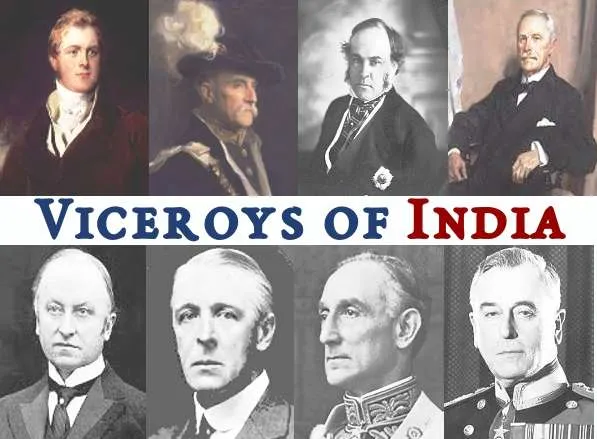
List of All Viceroys in India (1858-1947)– This article consists of the list of viceroys in India from 1858 to 1947.
- The title of viceroy was introduced post the battle of 1857.
- “Lord Canning” was the last Governor-General of India and also the first Viceroy of British India.
- The British government witnessed the mismanagement by the East India company and therefore the government introduced a representative head titled as the Viceroy of India.
- Here is the list of Viceroys in India from 1858-1947 and Important events happened during their tenure.
- This period witnessed various important events in India including the formation of “Indian National Congress” (INC) in 1885 during the reign of Lord Dufferin, Shifting of capitals from Calcutta to Delhi in 1911, Round Table Conferences in which Mahatma Gandhi was also a part. Various Acts signed and many more.
- This section must not be ignored by the candidates preparing for any competitive exams as most of the questions are directly asked form this period. List of All Viceroys in India (1858-1947)
Last Governor General of British India – Lord Canning
First Viceroy of British India – Lord Canning
Last Viceroy of British India – Lord Mountbatten
Last Governor General of Independent India – C.R Rajagopalachari
Latest Current Affairs 2023: Weekly, Monthly Current Affairs (PDF)
List of All Viceroys in India (1858-1947)
| S.No. | Viceroy | Period | Important events during their reign |
| 1 | Lord Canning | 1858-62 | He was the last Governor-General and first Viceroy of British India Concept of Budget was started in 1860 by James Wilson “Income Tax Act” (1858) “Income Councils Act” (1861) Revolt of 1857 took place. |
| 2 | Lord Elgin I | 1862-63 | Suppression of Wahabi Movement |
| 3 | John Lawrence | 1864-69 | Establishment of High court in Calcutta, Madras (1865) Bhutanese War (1864-65) Indian Forest Department were setup (1865) |
| 4 | Lord Mayo | 1869-72 | First Census (Irregular) in India (1872) Establishment of “Statistical Survey of India” Financial Decentralization in India First Viceroy in the Histroy who was killed during his reign. |
| 5 | Lord Northbrook | 1872-76 | Kuka Movement in Punjab (1872) Civil Marriage and Arya Samaj introduced. Intercaste Marriage allowed. Introduction of “Universersal Marriage Act” (187) |
| 6 | Lord Lytton | 1876-1880 | Vernacular Press Act (1878), Arms Act (1878) Organised 1st Grand Durbar in Delhi (1877) Maximum age to take up civil services exam lowered from 21 to 19. Abolished tax on cotton for British traders |
| 7 | Lord Rippon | 1880-84 | 1st Census (regular) in India Passed the 1st Factory Act in 1881 Passed “Local Government Act” in 1882 Introduced the infamous Ilbert Bill in 1883 Also known as the Father of Panchayati Raj System. |
| 8 | Lord Dufferin | 1884-88 | 3rd Burmese War (1885) “Indian National Congress” (INC) was founded in 1885. |
| 9 | Lord Lansdowne | 1888-94 | Passed the 2nd Factory Act in 1891 Indian Councils Act 1892 (Indirect election was introduced for the 1st time) Appointed Durand Commission in 1893 |
| 10 | Lord Elgin II | 1894-99 | Great Famine (Drought) in India occur in 1895 and so he appointed Lyall Commission He was killed by Chapekar (Ramkrishna & Damodar) Brothers. This was the first political murder. |
| 11 | Lord Curzon | 1899-1905 | Death of “Queen Victoria” in 1901 and he built Victoria Memorial in Calcutta Pass “Indian Coinage and Paper Currency Act (1899) Police Commission (1902) under Andrew Frazer Universities Commission (1902) under Thomas Railey Pass “Indian Universities Act” in 1904 Pass “Ancient Monument Protection Act” in 1905 Partition of Bengal (1905) |
| 12 | Lord Minto-II | 1905-10 | Swadeshi Movement started. Formation of All India Muslim League (1906) in Dhaka Founder- Nawab Khwaja Salimullah Split of Congress (1907) at Surat. Morley- Minto Reform |
| 13 | Lord Hardinge -II | 1910-16 | Transfer of capital from Calcutta to Delhi (1911) Construction of Gateway of India to welcome King George V Partition of Bengal cancel (1911) Hindu Mahasabha was established (1915) by Madan Mohan Malviya. 1st Women University was started in Pune |
| 14 | Lord Chelmsford | 1916-21 | Home Rule League Movement started Lucknow Pact (1916) signed. Champaran Satyagraha (1917) for Indigo cultivation. Kheda Satyagraha (1918) for Land Taxes Ahmedabad Satyagraha (1919) for Plague Passed Rowlatt’s Act in 1919. Montague-Chelmsford August Declaration (1917) Non-Cooperation Movement (1920) started |
| 15 | Lord Reading | 1921-26 | Khilafat Movement (1921) started. Chauri Chaura incident (1922) took place resulting in withdrawal of Non-Cooperation Movement. Swaraj Party (1922) was formed by C.R Das & Motilal Nehru. Kakori Train Incident (1925) took place |
| 16 | Lord Irwin | 1926-31 | Diwali Declaration (1929) Launch of Civil Disobedience Movement and Dandi March (1930) 1st Round Table Conference (1930) was held. Gandhi- Irwin Pact (1931) |
| 17 | Lord Willingdon | 1931-36 | 2nd Round Table (1931) & 3rd Round Table (1932) were held. Poona Pact (1932) was signed between Dr. B.R Ambedkar & Mahatma Gandhi. Communal Award (1932) was started. Congress Socialist Party (1934) |
| 18 | Lord Linlithgow | 1936-1944 | 1st General Election (1936-37) Lahore Resolution (1940) Quit India Movement (1942) Cripps Mission (1942) |
| 19 | Lord Wavell | 1944-47 | C.R Formula (1944) Launch of “Direct Action day” (1946) INA Trials & Naval Mutiny (1946) Wavell Plan & Shimla Conference (1945) |
| 20 | Lord Mountbatten | 1947-48 | He was the last Viceroy and first Governor General of free India Mountbatten Plan (1947) |
Note: C.R Rajagopalachari was the last Governor General of Independent India.
Viceroys of India (Frequently Asked Questions)
Q1)Who was the first Viceroy of India?
Ans. Lord Canning was the first Viceroy of India. His tenure lasted for four years between 1858 to 1862.
Q2) Who is a Viceroy?
The Governor-General of India was given the title of Viceroy, that is, a personal representative of the Crown. This is one of the important changes after the British Parliament passed a new Act in 1858 and transferred the powers of the East India Company to the British Crown in order to ensure more responsible management of Indian affairs.
Q3) Who was the first Viceroy of India after independence?
Lord Mountbatten was the last Viceroy of India and the first Governor-General of independent India. He was sent as Viceroy to India in March to make arrangements for the transfer of Power by June 1948.
Q4) Who was the last Viceroy of India?
Ans. Lord Mountbatten (1947-48) was the last viceroy of the British Indian Empire and the first Governor-General of independent India.
Q5) Who was the last Governor-General of Independent India?
Ans. C.R Rajagopalachari was the last Governor-General of Independent India.
